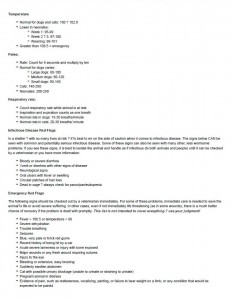First Aid
A pet first aid kit is the first step in being prepared should an animal emergency happen.
While there are many pre-made kits that may be purchased for pets building your own kit, or adding to a pre-made one, may be the best way to have a kit customized for your pet’s lifestyle and needs.
There are first aid items that are necessary for any kit.
I have included a description of each item to help with your kit choices.
Items to Include in Your first aid Kit
• Scissors – for cutting out things matted in fur, freeing your pet from entanglements.
• Sterile eye wash – make sure it is eye wash, not contact lens solution.
• Tweezers – to remove splinters, or other foreign materials from wounds.
• Tick remover tool – if you are in a tick-infested area, consider one of many tools to easily remove ticks and reduce additional damage or infection during removal.
Ear wash – speak to your vet about what one would be best for your pet.
• Toenail trimmer and styptic pencil – for torn toe nails Cornstarch also works for torn nails, but not for skin wounds.
• QuikClot or similar – to stop bleeding (wounds).
• Tape – preferably the 1″ white medical tape. Easy to tear off and holds well.
• Roll Gauze – used for bandaging, an aid to stop bleeding, and padding for splints.
• Vet Wrap – this is a conforming bandage wrap used over a telfa pad or roll gauze that comes in many colors and two sizes (2″ and 4″ – pick one that best fits your pet). It clings to itself and is semi-watertight. Caution is advised to not wrap this too tight. It is best to unwrap it from the roll, then use it for the bandage with very light tension. It can be purchased at many feed stores (horse section) and some veterinary clinics.
• Telfa pads – non-stick dressings for bandaging a wound.
• Bandage Scissors – these scissors have a blunted blade to easily slip between skin and bandage material and not cut the patient’s skin.
• Antiseptic wash or wipes – look for non-stinging preparations such as chlorhexidine or betadine. Rubbing alcohol is not good for open sores or wounds.
• Antibiotic ointment – over-the-counter “general purpose” antibiotic ointment for light use with minor skin wounds. Not for eye use. Caution is advised for animals that may ingest by licking. The antibiotics are absorbed via the skin, remaining ointment may collect debris or actually slow healing in some cases. Use with discretion.
• Vet-prescribed pain relief (NSAID) – speak to your vet about obtaining as-needed first aid kit pain relief. Do not use human prescription or over-the-counter pain medications for pets. Some medications, like Tylenol, are poisonous and may be fatal to pets.
• Latex or plastic exam gloves – for your protection and your pet’s protection – use when the situation is messy.
• A muzzle – or materials to make a muzzle. Even the most well-trained animals may bite when injured or afraid.
• Thermometer – know the normals for dog and cat vital signs and how to use the thermometer.
• Water-based lubricating jelly – for use with rectal thermometers.
• Ice and hot packs – cool down skin after a burn or keep an animal warm if hypothermic. Always use a cloth between the pack and skin and check frequently for redness or irritation.
• Extra towels, wash cloths and a blanket – use for washing, keeping warm/cool, and if necessary, a way to transport the injured pet (sling).
• Diphenhydramine (aka Benadryl) – for stings and allergic reactions – speak with your vet first about proper dosing.
• Syringe or large eye dropper – to flush wounds or administer fluids by mouth.
• A list of phone numbers – your regular vet, the emergency vet, animal control, and animal poison control numbers.
Another tip: program these numbers in your cell phone.
• A sturdy box – ideally plastic or metal – to hold all of your supplies and is easy to carry and pack with you will complete your kit.
Customizing A First Aid Kit for Your Pet
Different species, age groups, and pet lifestyles have different first aid kit needs. For example, a ferret or diabetic pet kit should include honey or corn syrup in the event of a low blood sugar episode. Pets who take medications regularly should have a couple days supply of all current medications (be sure to rotate meds to make sure they don’t expire). A back country or hunting dog kit may also include a meta-splint in the event of a broken leg.
Your veterinarian can help you customize a first aid kit to meet your pet’s additional medical needs.
Building a First Aid Kit Isn’t Enough
Purchasing or building a kit is a great first step, but won’t be a lot of help in the event of an emergency if you are not familiar with how and when to use the items.
Take a Pet First Aid Course to familiarize yourself with all you need to know – have it become second nature, so that when the emergency happens you can think quickly.

